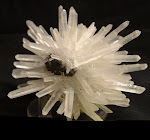Pluto's Two Small Moons Officially Named Nix and Hydra
A pair of small moons that NASA's Hubble Space Telescope discovered orbiting Pluto now have official  names: Nix and Hydra. Photographed by Hubble in 2005, Nix and Hydra are roughly 5,000 times fainter than Pluto and are about two to three times farther from Pluto than its large moon, Charon, which was discovered in 1978.
names: Nix and Hydra. Photographed by Hubble in 2005, Nix and Hydra are roughly 5,000 times fainter than Pluto and are about two to three times farther from Pluto than its large moon, Charon, which was discovered in 1978.
The names were approved this week by the International Astronomical Union (IAU), the recognized authority for assigning designations to celestial bodies.
In Greek mythology, Nyx is the goddess of the night. Among her many offspring was Charon, the boatman who ferried the dead across the river Styx into the Underworld. (Because asteroid 3908 already bears the Greek name Nyx, the IAU decided to use the Egyptian equivalent, Nix, for the name of Pluto's moon.) The mythological Hydra was a nine-headed serpent with poisonous blood. The Hydra had its den at the entrance to Hades, where Pluto and his wife Persephone entered the Underworld.
The team of researchers who selected the names, out of a list of more than two- dozen candidate names, used Hubble images to make the discovery in support of NASA's New Horizons mission to Pluto and the Kuiper Belt beyond. Team members are based at Southwest Research Institute (SwRI) in Boulder, Colo., the Johns Hopkins University Applied Physics Laboratory (APL) in Laurel, Md., the Space Telescope Science Institute in Baltimore and Lowell Observatory in Flagstaff, Ariz.
"You're going to be hearing a lot more about Nix and Hydra in coming years, says co-leader of the discovery team, Alan Stern of SwRI. "Astronomers are already applying for telescope time to study their orbits and physical properties. And when New Horizons flies by Pluto in the summer of 2015, each moon will be mapped in detail."
In making the selection, team members explained that Nix and Hydra honor the search for new satellites and the New Horizons mission to Pluto by starting with the letters "N" and "H." The first letter of Hydra also honors the Hubble Space Telescope that was used to detect the satellites. This has historical tradition. Pluto's name begins with the letters "P" and "L" to honor Boston astronomer Percival Lowell, who inaugurated the search that led to Pluto's discovery. (Lowell did not live to see Pluto's discovery, which was made by Clyde Tombaugh at Lowell Observatory in 1930.)
Object Names: Pluto, Charon, Nix, Hydra
Image Type: Astronomical/Illustration
Credit: NASA, ESA, H. Weaver (JHU/APL), A. Stern (SwRI), and the HST Pluto Companion Search Team































Nessun commento:
Posta un commento